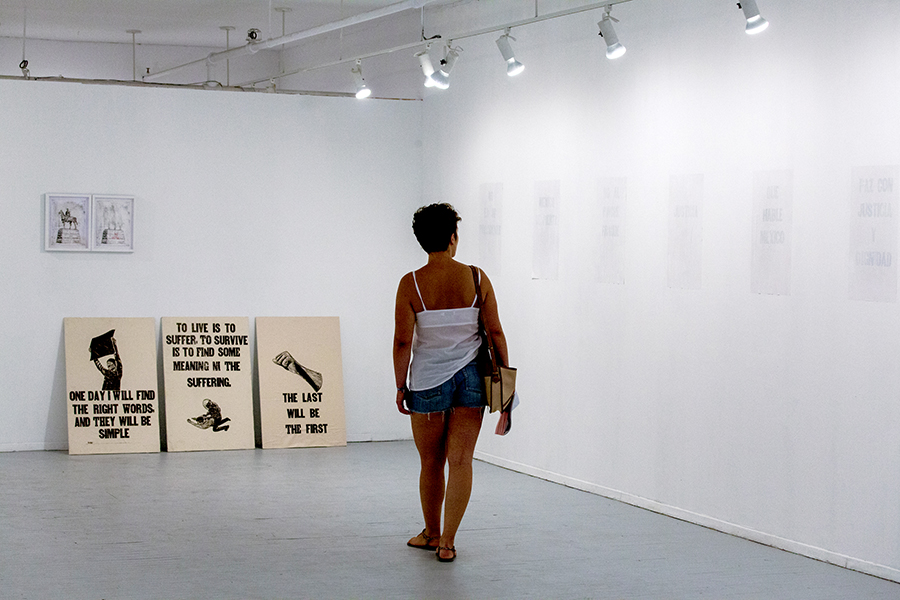Upon entering ARPRIM – one of the many galleries of the Belgo building, which is host to a number of Montreal’s art studios and exhibition spaces – you might find the room, well, empty. Apart from the large posters carrying famous revolutionary slogans sitting on the floor at each end of the room, the room appears to be almost blank. This emptiness remains even when you notice the black print which appears beneath a translucent coat of white paint on the walls of either side of the room.
Guillermo Trejo began his project “Protesta” about three years ago when he decided to draw attention to the political uprisings in Mexico. At the time, in 2009, the Mexican population was engaged in several protests against their current government and the local elections that were currently underway, demonstrating disappointment in the elected political party and questioning the legitimacy of the electoral process itself. About a year ago, when Trejo’s project was receiving attention from different galleries, a similar backlash once again erupted in Mexico, this time with regard to the Mexican general elections. The majority of Mexican media outlets, which are suspected to have been coerced by the government itself, underreported these two social uprisings. For Trejo, this project has always been a “fresh” subject, worthy of discussion. However, to call his work a conceptual exploration of the exchange of ideas within the public sphere, as the ARPRIM does in introducing Trejo’s project, is to fundamentally exaggerate the exhibit’s power.
“Protesta” is comprised of a series of hardly visible revolutionary slogans that hang on opposite sides of the gallery space. Trejo retrieved these slogans from photographs of the Mexican uprisings, which were published by certain media outlets, printed them on large sheets of paper, and had them covered in paint in order to illustrate how the Mexican government attempted to erase the traces of such protests. According to the ARPRIM gallery, Trejo attempts to explore a certain socio-political tension that is both shaped and accentuated by conflicts surrounding the use of public space.
Trejo’s work is unique in that it uses the raw revolutionary material in question as a source of inspiration behind the exhibit. But his work does not fully engage with or explore the material in question as it merely reproduces it within a modern art space. In doing so, Trejo has separated these original inscriptions from their politically and socially charged contexts, reproduced them in a clean and calculated fashion, and, it would seem, almost cleansed them of any sense of cultural dynamism or revolutionary struggle. Moreover, the slogans in question are prototypical revolutionary mottos (e.g., “To live is to suffer, to survive is to find meaning behind the suffering”) further impeding any expression of the character and individuality of these protests.
Although Trejo’s intent may in fact have been to explore the power of words as used in public discourse by distancing them from their context, he provides them with so little contextualization that they fail to resonate with the viewer. It is almost too obvious that the artist himself has taken on the roles of both protester and government by producing the posters and covering them up, leaving the artworks themselves empty of any sense of the clash in Mexico’s streets.
The seemingly effortless physical production of these thinly covered posters combined with the banality of the slogans themselves weakens his message. In all of this, Mexico seems lost, the pieces of “Protesta” fade into the background, and Trejo’s work serves as little more than a quiet reminder that social activists and the state often, as we already know, stand in opposition to one another.
“Protesta” will be running at ARPRIM (372 St. Catherine W., # 426) until October 5.
